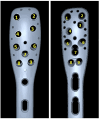Pre-operative virtual three-dimensional planning for proximal humerus fractures: A proof-of-concept study
- PMID: 39329064
- PMCID: PMC11423366
- DOI: 10.1177/17585732241232889
Pre-operative virtual three-dimensional planning for proximal humerus fractures: A proof-of-concept study
Abstract
Purpose: To (1) evaluate surgeon agreement on plating features (position and screw length) in virtual 3D planning software, (2) describe outcomes (fracture reduction, plate position, malpositioning of calcar screws and screw lengths) of plate fixations planned with routine pre-operative assessment (2D- and 3D CT imaging) and those planned with dedicated virtual 3D software of the same proximal humerus fracture.
Methods: Fourteen proximal humerus fractures were retrospectively reduced and fixed with virtual planning software by eight attending orthopaedic surgeons and compared to the true surgical fixation with post-operative computed tomography (CT) scans. Reduction differences were quantified using CT micromotion analysis.
Results: Intraclass correlation for screw lengths was 0.97 (95% CI: 0.96-0.98) and 0.90 (95% CI: 0.79-0.96) for plate position. Mean difference in total fracture rotation of the head between the virtual and conventional group was 22.0°. Plate position in the virtual planning group was 3.2 mm more proximal. There were no differences in inferomedial quadrant calcar screw positioning and, apart from the superior posterior converging screw, no significant differences in screw lengths.
Conclusion: Reproducibility on plate position and screw length with virtual planning software is adequate. Apart from fracture reduction, virtual planning yielded similar plate positions, screw malpositioning rates and lengths compared to routine pre-operative assessment.
Keywords: 3D virtual planning; CT micromotion analysis; calcar screws; plate position; proximal humerus fractures; reduction; screw lengths; surgical planning.
© The Author(s) 2024.
Conflict of interest statement
The author(s) declared the following potential conflicts of interest with respect to the research, authorship, and/or publication of this article: Each author certifies that he or she has no commercial associations (e.g., consultancies, stock ownership, equity interest, patent/licensing arrangements, etc.) that might pose a conflict of interest in connection with the submitted article. During the study period, one author (RS) received payments with an amount between USD 10,000 and USD 100,000 from Prins Bernhard Cultuurfonds (Amsterdam, the Netherlands), and Flinders Foundation (Adelaide, Australia); payments with an amount less than USD 10,000 from Michael van Vloten Foundation (Rotterdam, The Netherlands) and Anna Fonds NOREF (Mijdrecht, the Netherlands).
Figures








References
-
- Gardner MJ, Weil Y, Barker JU, et al. The importance of medial support in locked plating of proximal humerus fractures. J Orthop Trauma 2007; 21: 185–191. - PubMed
-
- McMillan TE, Johnstone AJ. Primary screw perforation or subsequent screw cut-out following proximal humerus fracture fixation using locking plates: a review of causative factors and proposed solutions. Int Orthop 2018; 42: 1935–1942. - PubMed
-
- Omid R, Trasolini NA, Stone MAet al. et al. Principles of locking plate fixation of proximal humerus fractures. J Am Acad Orthop Surg 2021; 29: E523–E535. - PubMed
LinkOut - more resources
Full Text Sources
